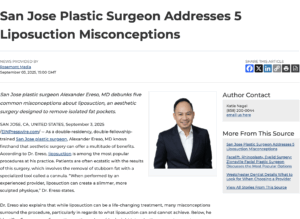What Is Gynecomastia and How Is It Treated?

Gynecomastia is a term that means “enlarged male breasts.” Studies show that nearly half of all men will experience gynecomastia during their lives. Physically, it is not a cause for concern; however, it can be psychologically difficult to accept. Many men with gynecomastia feel uncomfortable or self-conscious of their bodies. Luckily, plastic surgeons have developed a solution: male breast reduction surgery.
Dr. Alexander Ereso treats gynecomastia at their Mountain View-based plastic surgery practice. Here, they explain what causes the condition, and what can be done about it.
Causes of Gynecomastia
Gynecomastia is primarily caused by a hormonal imbalance. If a man develops high estrogen levels, his body will start to produce more breast tissue and his chest will look larger. Other possible causes include:
- Medications – e.g., anti-depressants, anti-anxiety medications
- Drugs and alcohol – e.g., marijuana
- Medical problems –e.g., kidney or liver disease, hyperthyroidism
Some men develop gynecomastia simply as the result of the aging process.
During your consultation, the plastic surgeon will take down a detailed health history to rule out any medical problems that could be causing excessive breast tissue. He will ask for a list of medications you currently take, including nutritional supplements and herbal remedies, and look for any drugs that could be contributing to the problem.
Certain cases of gynecomastia will resolve over time. If yours does not, and you are struggling with the appearance of enlarged breasts, you may opt for surgical treatment.
Gynecomastia Treatment
Gynecomastia surgery removes excess glandular and fatty tissue to produce a flatter, firmer and more masculine-looking chest.
Your treatment plan will be tailored to your unique needs, but generally, the surgical steps are as follows:
First, the plastic surgeon will make an incision along the lower edge of the nipple-areola complex. He will surgically excise excess glandular tissue to flatten the breasts. Then, he will use ultrasound-assisted liposuction techniques to remove localized fat deposits and “fine-tune” the results. Finally, he will close the incisions with sutures.
Swelling and mild discomfort are normal post-operative side effects, and will subside within a few weeks. The plastic surgeon will likely place a supportive garment around the chest to control the swelling.
While initial results are noticeable almost immediately after surgery, it can take several months for the full results to appear. Since the surgical incision is small, scarring is minimal.
Learn More about Gynecomastia Treatment
If you feel self-conscious about excessive breast tissue and desire a more masculine-looking chest, please contact our plastic surgeon, Dr. Alexander Ereso, today and book a consultation.


